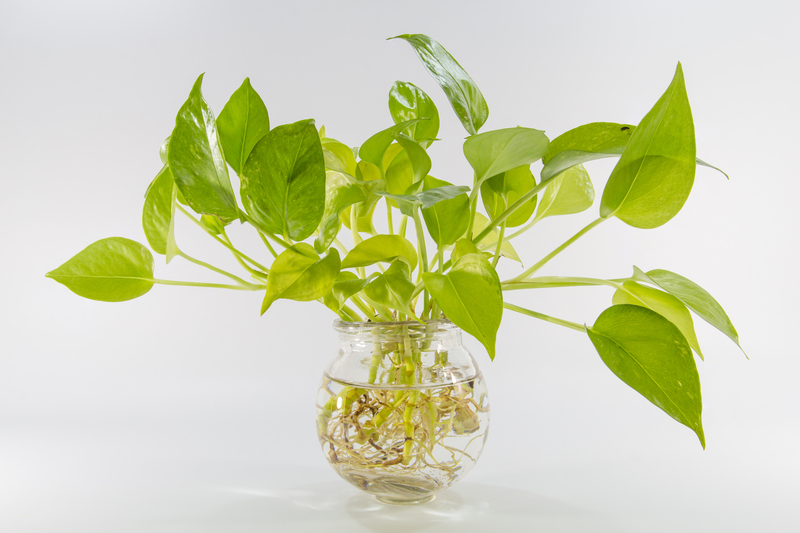Innovative Approaches to Vertical Gardening
Posted on 13/06/2025
Innovative Approaches to Vertical Gardening
Vertical gardening stands at the forefront of urban horticulture, blending creativity, sustainability, and technology to revolutionize conventional gardening. As cities grow denser and green spaces dwindle, *innovative solutions* for cultivating plants in compact areas become ever more essential. This article delves into cutting-edge vertical gardening techniques, highlights the latest trends, and offers practical guidance to help you transform walls, balconies, and even indoor spaces into thriving green oases.

Understanding Vertical Gardening: An Overview
Vertical gardening refers to the practice of growing plants upwards, supported by structures such as walls, trellises, or custom-built frameworks, rather than spreading them across horizontal garden beds. The concept spans from simple DIY hanging planters to complex hydroponic living walls.
- Space Efficiency: Perfect for apartments, balconies, and tiny urban lots.
- Air Quality Improvement: Plants filter pollutants and supply breathable oxygen.
- Aesthetic Value: Living walls serve as unique focal points, both indoors and out.
- Energy Savings: Properly placed vertical gardens naturally insulate buildings, reducing energy consumption.
Why Go Vertical?
In addition to solving the problem of limited space, adopting innovative vertical garden ideas allows city dwellers to enjoy fresh herbs, flowers, or even vegetables year-round. Vertical farming techniques also reduce the risk of soil-borne diseases and pests, as plants are elevated off the ground.
Key Innovations Shaping the Future of Vertical Gardening
Modern vertical gardening is moving beyond traditional climbers and trellises. Let's explore the most groundbreaking approaches making vertical gardens more efficient, attractive, and sustainable.
1. Modular Green Wall Systems
Gone are the days of heavy, awkward wall planters. Modular green wall systems use lightweight, interchangeable panels made from recycled materials. These panels feature built-in irrigation and drainage, making them easy to maintain. Some of the leading brands even offer customizable patterns, allowing homeowners to tailor their green wall's look and plant selection to suit their spaces.
- Benefits: Quick installation, flexibility, and ease of maintenance.
- Popular Uses: Office lobbies, restaurant interiors, urban apartments.
2. Smart Vertical Gardening With IoT Technology
Smart gardens leverage the Internet of Things (IoT) to make plant care nearly effortless. Sensors embedded in planters or soil monitor moisture, light, and nutrient levels. Paired with automated watering and lighting systems, vertical gardens can now thrive with minimal intervention from their owners.
- Features: Mobile alerts, remote control, adaptive schedules
- Benefits: Ensures optimal growing conditions, increases yield, reduces water waste
3. Hydroponic Vertical Farming
By forgoing soil altogether, hydroponic vertical gardens use mineral nutrient solutions to feed plants. This approach is particularly popular for edible crops like herbs, strawberries, and leafy greens. Systems can be wall-mounted towers, vertical tubes, or customized racks with cascading trays.
- Advantages: Faster growth, no weeding, reduced water usage
- Best For: Urban food production, indoor kitchen gardens
4. Recycling and Upcycling in Vertical Gardening
Eco-conscious gardeners embrace upcycling as a creative solution for building vertical gardens. Repurposing old wooden pallets, PET bottles, gutters, shoe organizers, or even ladders provides a budget-friendly and sustainable foundation for plant displays.
- Cost-effective: Reduces the need to purchase new materials.
- Personalized Style: Add character and uniqueness to your vertical garden design.
5. Biophilic Design and Living Art Installations
Integrating vertical gardening with biophilic design principles enhances both aesthetics and well-being. Artistic living wall installations incorporate a mix of textures, colors, and plant species to mimic natural landscapes, transforming blank walls into immersive green habitats. These living art pieces are increasingly used in commercial buildings, hotels, and modern homes.
- Mental Health Benefits: Exposure to greenery reduces stress and boosts creativity.
- Environmentally Friendly: Supports biodiversity and improves indoor air quality.
Choosing the Right Plants for Your Vertical Garden
Successful vertical gardening hinges on matching plant selection to your environment's unique characteristics. Consider factors such as light exposure, temperature, humidity, and water availability when making selections. Here are some popular choices:
- Herbs: Basil, mint, parsley, cilantro--ideal for kitchen vertical gardens.
- Leafy Greens: Lettuce, arugula, spinach--thrive in hydroponic towers.
- Ornamentals: Ferns, pothos, philodendrons--excellent for low-light, indoor spaces.
- Flowering Plants: Petunias, impatiens, nasturtiums--for colorful, outdoor vertical setups.
- Succulents: Sedum, echeveria--a great option for sunny walls with low moisture.
Tips for Plant Selection
- Mix and Match: Combine varying textures, colors, and sizes for visual interest.
- Grow Edibles: Cherry tomatoes, strawberries, peppers, and beans work well in vertical vegetable gardens.
- Assess Requirements: Group plants by similar water and light needs.
Step-by-Step Guide to Creating an Innovative Vertical Garden
Ready to build your own cutting-edge vertical oasis? Here's a simple roadmap to get started:
- Determine the Location
- Assess sunlight, shade, wind, and exposure to the elements.
- Choose between indoors (walls, stairwells, kitchens) or outdoors (fences, balconies, patios).
- Select a Vertical Garden System
- Evaluate commercial green wall panels, DIY upcycled structures, hydroponic towers, or trellis-based systems.
- Consider space, budget, and desired aesthetics.
- Install Irrigation and Drainage
- Automated drip systems or self-watering planters work best for maintenance.
- Ensure excess water can drain away to prevent root rot.
- Choose and Arrange Plants
- Plan for accessibility, light requirements, and visual balance.
- Monitor and Maintain
- Leverage smart monitoring systems for optimal plant health.
- Prune, fertilize, and clean as needed for long-term success.
Advanced Trends in Vertical Gardening
Enthusiasts and professionals alike continually push the boundaries of conventional gardening with new approaches. Several advanced trends stand out in this evolving field:
Integrating Edible Vertical Gardens in Urban Agriculture
Urban vertical farms are now common in cities, maximizing limited space to grow fresh produce for local consumption. Restaurants, offices, and schools embrace these installations to teach sustainability, supplement menus, and improve air quality. Systems like aeroponic towers--where plant roots are misted with nutrients--are particularly efficient for high-density food production.
Incorporating Renewable Energy
Innovative vertical gardens are increasingly integrated with renewable energy. Solar-powered irrigation pumps or lighting systems allow green walls to thrive off the grid. This fusion of green technology and gardening offers a sustainable path forward for eco-conscious consumers and businesses.
Community and Therapeutic Applications
Hospitals, schools, and community centers recognize the therapeutic benefits of living walls. Participation in creating and maintaining these gardens fosters a sense of community, improves mental health, and promotes environmental stewardship.
Artificial Intelligence (AI) in Vertical Gardening
Leading growers adopt AI-powered systems to optimize plant care. By analyzing environmental data, AI can adjust watering, lighting, and nutrient supply to suit the precise needs of each plant, maximizing both growth and resource efficiency.
Common Challenges and Solutions in Innovative Vertical Gardening
Like any horticultural endeavor, vertical gardening presents unique challenges:
- Water Distribution: Ensuring all plants receive adequate moisture, especially on large green walls.
- Plant Disease: Vertical gardens can suffer from mildew or root rot if not ventilated properly.
- Structural Integrity: Ensuring walls or supports can handle the weight of built-out gardens and retained water.
How to Troubleshoot Vertical Garden Issues
- Choose the Right System: Opt for pre-tested modular designs with engineered drainage and water flow.
- Regular Maintenance: Inspect for pests, disease, and mechanical wear to prevent costly problems.
- Consult Experts: For large installations, work with experienced professionals or landscape architects.

Optimizing SEO and Online Resources for Vertical Gardening
Staying updated with the latest vertical gardening trends is easier than ever. Countless resources, online communities, and courses are available for beginners and advanced practitioners.
- Community Forums: Share tips and troubleshoot issues with fellow garden enthusiasts.
- Video Tutorials: Step-by-step guides are available for every kind of vertical garden system.
- Product Reviews: Find the best smart systems, green wall modules, and hydroponic kits with real user feedback.
- Online Plant Care Tools: AI-driven apps can diagnose problems and track plant health.
Conclusion: The Future of Vertical Gardening Is Here
As cities become denser and environmental challenges mount, innovative vertical gardening methods offer a sustainable, beautiful, and space-efficient solution for urban dwellers and commercial enterprises alike. By embracing new technologies, recycled materials, and creative design principles, everyone can cultivate lush, productive ecosystems in places once thought impossible.
Whether you're an apartment resident with a tiny balcony or a business owner seeking a vibrant living wall, the latest approaches to vertical gardening empower you to bring nature closer to home. Harness these dynamic trends to improve air quality, enrich your well-being, and contribute to a healthier, greener world.
Embrace the revolution. Start your vertical garden journey with today's innovative approaches and transform your space--vertically and sustainably.

